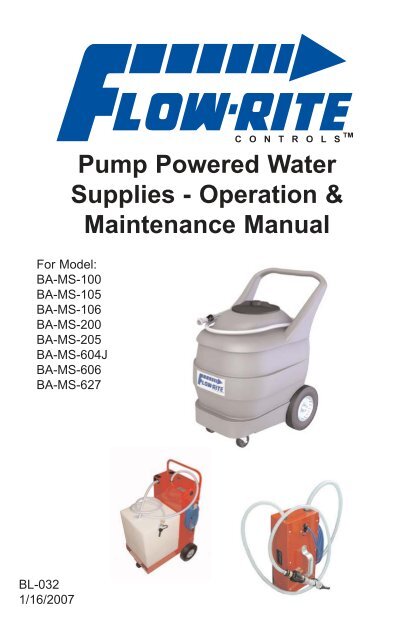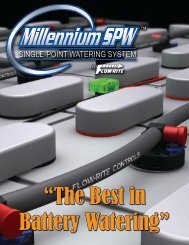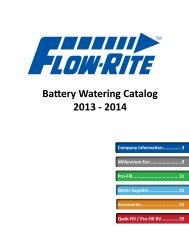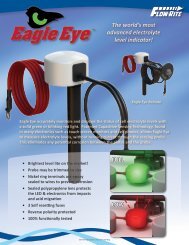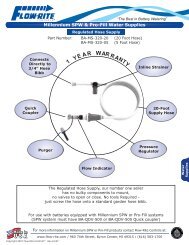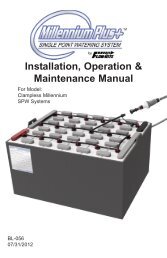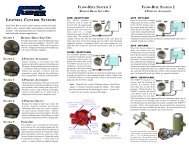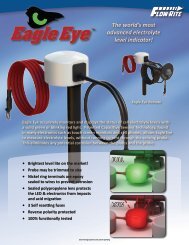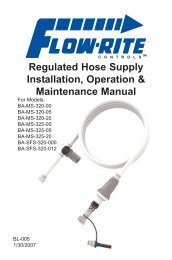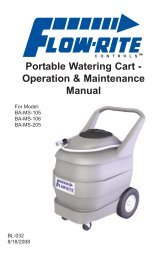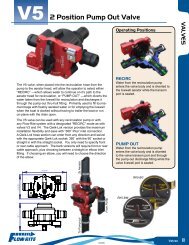Pump Powered Water Supplies - Flow-Rite
Pump Powered Water Supplies - Flow-Rite
Pump Powered Water Supplies - Flow-Rite
- No tags were found...
Create successful ePaper yourself
Turn your PDF publications into a flip-book with our unique Google optimized e-Paper software.
<strong>Pump</strong> <strong>Powered</strong> <strong>Water</strong><strong>Supplies</strong> - Operation &Maintenance ManualFor Model:BA-MS-100BA-MS-105BA-MS-106BA-MS-200BA-MS-205BA-MS-604JBA-MS-606BA-MS-627BL-0321/16/2007
General Information & PrecautionsThis publication provides detailed instructions forinstalling the single point watering system kit and/orrelated water supply. Thoroughly review thisdocument before any installation procedures areperformed.The following safety statements relate to specific safety issues and must beread, understood, and heeded before a kit is installed. Failure to do so couldresult in personal injury and/or property damage.DANGER• Battery – Explosive gases! Do not smoke. Keep sparks and flames away fromthe vehicle and service area. Ventilate when charging or operating vehicle inan enclosed space. Wear a full face shield and rubber gloves when working onor near batteries.• Battery – Poison! Contains acid! Causes severe burns. Avoid contact withskin, eyes, or clothing. Antidotes:- External: Flush with water. Call a physician immediately.- Internal: Drink large quantities of milk or water. Follow with milk ofmagnesia or vegetable oil. Call a physician immediately.- Eyes: Flush with water for 15 minutes. Call a physician immediately.WARNING• Follow the procedures exactly as stated in this instruction, and heed allDANGER, WARNING, and CAUTION statements in this instruction as well asthose on the vehicle and battery charger.• Only trained technicians should service or repair the single point wateringsystem. Anyone doing even simple repairs or service should have knowledgeand experience in plumbing, electrical and mechanical repair. The appropriateinstructions must be used when performing maintenance, service, or accessoryinstallation.• Prior to servicing the vehicle or leaving the vehicle unattended, turn the keyswitch OFF, remove the key, and chock the wheels when servicing the vehicle.• Wear safety glasses or approved eye protection when servicing any part of thewatering system. Wear a full face shield and rubber gloves when working onor near batteries.• Do not wear loose clothing or jewelry such as rings, watches, chains, etc.,when servicing the vehicle or battery charger.• Moving parts! Do not attempt to service the vehicle while it is running.• Hot! Do not attempt to service hot engine, exhaust system, or motor. Failure toheed this warning could result in severe burns.• Use insulated tools when working near batteries or electrical connections. Useextreme caution to avoid shorting of components or wiring.• If wires are removed or replaced, make sure wiring and wire harness areproperly routed and secured. Failure to properly route and secure wiring couldresult in vehicle malfunction, property damage, personal injury, or death.2
Battery MaintenanceDeep cycle batteries need water. More importantly, water mustbe added at the right time and in the right amount or the battery’sperformance and longevity suffers.Checking and maintaining the electrolyte levels in your batteriescan save thousands of dollars by preventing early battery failuredue to cell dilution and imbalance. Although adding water tobattery cells is considered a tedious job, it is a necessity.Electrolyte levels drop during discharge and rise during charge.Therefore, it is imperative that electrolyte levels be checked andadjusted after the batteries are fully charged. Adding watercorrectly using a <strong>Flow</strong>-<strong>Rite</strong> Single Point <strong>Water</strong>ing system helpsmaintain the electrolyte level among the battery cells.<strong>Water</strong> must be added after fully charging the battery. Prior tocharging, there should be sufficient water to cover the plates. Ifthe battery has been discharged (partially or fully), the water levelshould still be above the plates.Subsequent watering intervals are dependent on the localclimate, charging methods, application, and age of batteries.<strong>Flow</strong>-<strong>Rite</strong> recommends that new batteries be checked once amonth and older batteries be checked weekly until you get a feelfor your water consumption rate.3
Package ContentsMillennium <strong>Pump</strong><strong>Powered</strong> <strong>Water</strong> SupplyQTY x 1BA-MS-100 & 200 differ in appearance from cart pictured aboveModelNumberBA-MS-100BA-MS-105BA-MS-106PowerRequirement115 VAC100-115 VAC100-240 VACBattery Requirements12 VDCGroup 27 Customer Supplied12 VDC (sealed)Included12 VDC (sealed)IncludedBA-MS-200 115 VAC Not ApplicableBA-MS-205 115 VAC Not ApplicableBA-MS-604J 115VAC Not ApplicableBA-MS-606 115 VAC Not ApplicableBA-MS-627 220 VAC Not Applicable4
<strong>Water</strong>ing Procedures1. <strong>Water</strong> After Charge- Electrolyte levels drop during discharge and rise during charge. In addition,charging generates heat, fluid expansion and explosive gases. <strong>Water</strong>ing abattery before charge (or with a low charge level) can lead to boil overresulting in potential damage of the watering system, battery and vehicle.<strong>Water</strong> must always be added after fully charging the battery. Prior tocharging, there must be sufficient water to cover the plates. If the batteryhas been discharged (partially or fully), the water level should still be abovethe plates.2. <strong>Water</strong>ing Intervals- <strong>Water</strong>ing intervals are dependent on the local climate, charging methods,application, and age of batteries. <strong>Flow</strong>-<strong>Rite</strong> recommends that new batteriesbe checked once a month and older batteries be checked weekly until youget a feel for your water consumption rate.Typically for a heavy use application, we recommend watering a maximumof once per week, and for light use applications once per month. Generallyit is best to water on Wednesdays for most applications. Specifically youshould not water a battery that has been sitting for an extended period oftime with no activity (non use or not on charge) such as a battery that hassat over the weekend. It is best to water a warm battery that has just beenfully charged.Important: <strong>Water</strong> quality is important to maintain the life of your batteryand watering system. Always use water that meets the qualityrequirements of your batteries’ manufacturer.5
OperationFor continued successful operation of your Single Point <strong>Water</strong>ingsystem always:1. Only use <strong>Flow</strong>-<strong>Rite</strong> approved equipmentWarning! Use of unapproved equipment or modificationof approved equipment can lead to systemfailure and will void your warranty2. Always follow <strong>Flow</strong>-<strong>Rite</strong>’s required watering procedures.3. Perform regular scheduled maintenance!4. For indoor use only!Warning! Only fill batteries after they have been fully charged.Step 1 - Fill Tank- Ensure the water supply has ample water to fill battery. Ifnecessary, remove lid and fill cart / holding tank with water. Allpump powered water supplies are compatible with deionized water.Step 2 - Power Up <strong>Water</strong> Supply- For AC powered water supplies first plug into a GFCI outlet. Seepower requirements of your specific models on page 4. Turn onrocker switch.- For DC powered (100 series) carts turn on rocker switch, andcheck voltage meter to ensure battery is charged. The cart shouldnot be operated once the voltage falls below 12 volts.Recharging Battery: Plug in battery charger (to a GFCI outlet)when cart is not in use to ensure the battery is fully charged. Theon-board charger will maintain charge levels as necessary. Seepage 4 for charger power requirements.NOTE: Once the water supply has been powered on, the pump willturn on briefly to develop pressure in the supply hose and then willturn off. The power switch can be left on in between refillingbatteries. The pumps will turn on occasionally to maintain pressurein supply hose. This occasional cycling will not damage the watersupply, although it is recommended that the water supply bepowered down if it will be inactive for 1 hour or more.6
Operation ContinuedStep 3 - Qualify <strong>Water</strong> Supply- Check flow rate through included purger by mating purger withhose end assembly. Verify that a minimum of 2 GPM (Gallons perminute) is achieved. This can be measured with a bucket and astop watch or a watch with a second hand.Note: Should a 2 GPM flow rate not be produced refer to thetroubleshooting guide in your water supply’s instruction booklet.PurgerHose End AssemblyStep 4- Remove Dust CoverStep 5 - Mate Couplers- Insert the male coupler on the spwsystem into the female coupler on theend of the water supply.Step 6 - Observe <strong>Flow</strong> Indicator- The red balls inside the flow indicatorwill begin to spin indicating that wateris flowing into the battery. As the cellsfill and the valves shut off, the balls willbegin to spin slower until they come toa stop. This indicates that all valveshave shut off and filling is complete.7
Step 7 - Disconnect- When the balls stop spinning,immediately disconnect the couplers bydepressing the push button on thefemale coupler. If the water supply isleft connected after the filling processis finished it could lead to an overfill.- CAUTION: If at any time during the filling process youhave a valve failure disconnect immediately.Step 8 - Replace Dust Cover- Place dust cover back over the malecoupler. Do not push cover past thelarge barb on the coupler.Tip:If you slightly squeeze the dust coverwhen sliding it over the coupler it willcreate a vacuum allowing it to holdtightly.8
Regular MaintenanceYour single point watering system requires regular preventativemaintenance on at least a quarterly basis.1. Check all screens and/or filters on water suppliesClean or replace all filters / line strainers as necessary. Failure to doso can cause a reduction in the water pressure and flow ratesneeded to operate the system properly. A filter screen can be foundon the inlet of all regulators, a line strainer and/or suction strainer onall suction hoses.BBACABARegulator Filter Line Strainer (B) Suction Strainer (C)Screen (A)Note: Pictures may differ slightly from your specific application. For RedCarts Suction Strainer is found inside of white holding tank andregulator is found inside of the red housing.2. Inspect the condition of all tubing connections, red end caps,swivel T's, and couplers.Make sure that all parts are in good working condition and aresecure, leak free, and properly connected. The coupler must have anO-ring and dust cover properly attached.3. Electrolyte Levels<strong>Flow</strong>-<strong>Rite</strong> recommends checking the electrolyte level in each cell foraccuracy after the system has been installed and operational forthree months. 9
Seasonal Maintenance<strong>Water</strong> <strong>Supplies</strong><strong>Water</strong> supplies must be drained and stored in an empty state if they will beexposed to freezing temperatures. Failure to do so can cause permanentdamage.<strong>Water</strong>ing SystemsIf you have vehicles that are taken out of service or put into storage for aperiod of 6 weeks or longer, your single point watering system will requireseasonal maintenance. No special steps need to be taken for winterizationof the SPW system that is mounted on the batteries; however, the followingsteps need to be followed when bringing your vehicle back into service:1. After the batteries have been fully charged / equalized, connect thesystem to its water supply for 3-5 seconds then disconnect regardless ofwhether or not the batteries are completely full.2. Return the vehicle to its regular service3. Place the vehicle back into its regular watering schedule (waiting at least1 week until next watering).10
Operating Specifications<strong>Flow</strong>-Rate:Pressure Range:Temp. Range:Operating Requirement of SPW system2-5 gallons per minute*3-35 PSI (no flow, static)Freezing - 150 O FFreezing- 65.5 O C<strong>Water</strong> supply Operating RequirementsInlet Pressure Range 40-100 PSI (no flow, static)Temp. Range33 - 150 O F1 - 65.5 O CAll product specifications should be met for proper operation of your <strong>Flow</strong>-<strong>Rite</strong> SPW system. Contact battery supplier or <strong>Flow</strong>-<strong>Rite</strong> Controls if youhave any questions regarding product specifications or how to verify awater supply.*<strong>Flow</strong> rate should be measured at the end of a purger (female / malecoupler combination).TroubleshootingIf you notice reduced run time on your vehicle check to see that each cellis filled to the proper level. In the event that a cell is not showing water,connect system to its water supply. Recheck the level of low cells. If theyare still low call for service. In the event that a valve does not shut off,qualify water supply to ensure that it is producing 2GPM (measured throughthe purger). If the water supply qualifies, call for service. If it does notqualify, perform Maintenance procedures and requalify. If it does not qualifyafter performing Maintenance call for service.1FLOW-RITE CONTROLS1 YEAR WARRANTYVisit www.flow-rite.com for details11
<strong>Flow</strong>-<strong>Rite</strong> Controls960 74th StreetByron Center, MI 49315PH: 616-583-1700 FAX: 616-878-5151www.flow-rite.comPrinted in USA © 1/2007Protected under U.S. & foreign patents and patents pending


